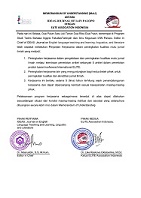Lexicons of Sugriwa Dance Movements in Wayang Wong Tejakula
DOI:
https://doi.org/10.24256/ideas.v11i1.3467Keywords:
lexicons, cultural meaning, movements, Sugriwa danceAbstract
Lexicons and their cultural meaning can be found in Sugriwa dance, Wayang Wong Tejakula. However, the uses of the lexicons and their cultural meaning are rarely used by the dancer from time to time. It can cause language death. This study was designed in the form of a descriptive qualitative method and aimed to find the lexicons and their cultural meaning. The obtained data were collected from observation and interview techniques. The results of the study show that there are 21 lexicons of movements. Those lexicons are categorized into head movements, such as kipekan capung and mengas, body movements, such as agem kanan, agem kiri, matang, nyalin ulat, ngalok-alok, ngadap, ngengsog, and raras, hand movements, such as anyingsing roma, nabdab gelung and ngagen, finger movement that is mudra suara, and leg movements, such as cicangan, dadengkleng, nyeregseg, ngeceb, tanjek kiri, tanjek kanan, and ngeteg. Of those 21 lexicons, only five lexicons have their cultural meaning. Those five lexicons become the characteristic movements of this dance and are classified into three dance stages: tanjek, ngalok-alok and nyeregseg are included in ngugal and have the cultural meaning of introducing the Sugriwa character. Ngengsog is included in pamahbah and has cultural meaning as telling the purpose of Sugriwa to come out to the stage. Ngalok-alok and ngadap are included in ngadap, which has cultural meaning as showing the leadership of Sugriwa's character. The findings and documentation about the lexicons and their cultural meaning in this dance can certainly be teaching material. The dance teachers can easily teach foreigners who want to learn this dance. In addition, it will help students who are interested in learning lexicons and their cultural meanings. In other words, this study can help preserve local languages and avoid language death.
References
Adityarini, I. A. P. (2016). Khazanah Leksikon Budaya Kepatungan di Desa Kemenuh Gianyar: kajian ekolinguistik. Denpasar: Udayana University Press.
Budhiono, R. H., & Tengah, B. B. K. (2017). Leksikon alat dan aktivitas bertanam padi dalam bahasa Jawa. Jurnal Kandai, 13(2), 235-248. https://doi.org/10.26499/jk.v13i2.210
Crystal, D. (2002). Language death. Cambridge University Press.
Devianty, R. (2017). Bahasa sebagai cermin kebudayaan. Jurnal tarbiyah, 24(2).
Dewi, A. A. I. M. D., Budasi, I. G., & Suarnajaya, I. W. (2020). Lexicons in legong keraton dance. Lingua Scientia, 27(2), 98-107.
Giri, I. M. A. (2017). Pelestarian bahasa, aksara, dan sastra Bali melalui pengoptimalan tripusat pendidikan. Purwadita: Jurnal Agama dan Budaya, 1(1), n.pag.
Heryadi, Y., Fanany, M. I., & Arymurthy, A. (2012). Grammar of dance gesture from bali traditional dance. International Journal of Computer Science, 149.
Kusuma, I. M. A. W., Budasi, I. G., & Suarnajaya, I. W. (2020). Lexicons of tabuh rah used in Menyali village Prasi: Jurnal Bahasa, Seni, dan Pengajarannya, 15(02), 71-83. https://doi.org/10.23887/prasi.v15i02.26906
Marjanto, D. K., Widjaja, I., Julizar, K., Hendrik, H., & Ulumuddin, I. (2020). Pengaruh pendaftaran tiga genre tari Bali dalam daftar ICH UNESCO bagi kehidupan: sosial ekonomi komunitas budaya. Pusat Penelitian Kebijakan, Badan Penelitian dan Pengembangan dan Perbukuan, Kementrian Pendidikan dan Kebudayaan.
Koten, I. L., & Pramartha, C. R. (2020). Semantic representation of balinese traditional dance. JELIKU (Jurnal Elektronik Ilmu Komputer Udayana), 8(4), 411. https://doi.org/10.24843/jlk.2020.v08.i04.p07
Murni, S. I., Tritanti, A., & Indadihayati, W. (2019). Pengembangan make up karakter sugriwa. Prosiding Pendidikan Teknik Boga Busana, 14(1).
Nurita, W., & Putri, I. G. A. V. W. (2021). Critical condition in Balinese lexicon extinction. Journal of Language and Linguistic Studies, 17(4), 1773-1786. https://doi.org/10.52462/jlls.129
Richards, J. C., & Schmidt, R. (2010). Longman Dictionary of Language Teaching and Applied Linguistics. Longman.
Ruastiti, N. M., Sudirga, I. K., & Yudarta, I. G. (2021). Wayang Wong Bali performance in era pandemic Covid 19. In IOP Conference Series: Earth and Environmental Science (Vol. 724, No. 1, p. 012109). IOP Publishing. https://doi.org/10.1088/1755-1315/724/1/012109
Sandelowski, M. (2000). Whatever happened to qualitative description?. Research in nursing & health, 23(4), 334-340. https://doi.org/10.1002/1098-240x(200008)23:4<334::aid-nur9>3.0.co;2-g
Satriawati. (2018). Seni Tari. Pusat Kegiatan Belajar Masyarakat PKBM Rumahbuku Carabaca
Sastrini, N. K. A. P., & Winarti, N. W. S. (2018). Wayang wong dalam upacara dewa yadnya di mrajan gede griya penida, desa batuagung, kabupaten Jembrana. VIDYA WERTTA: Media Komunikasi Universitas Hindu Indonesia, 1(1), 39-52. https://doi.org/10.32795/vw.v1i1.176
Sholihah, R. A., & Suharti, S. (2015). Sikap Dan pemertahanan Bahasa Indonesia siswa kelas X sma internasional budi mulia Dua Yogyakarta. LingTera, 2(2), 169. https://doi.org/10.21831/lt.v2i2.7375
Sibarani, T. (2019). Ekolinguistik kebambuan dalam masyarakat bahasa Batak Toba. MEDAN MAKNA: Jurnal Ilmu Kebahasaan dan Kesastraan, 12(2).
Sudibya, I. G. N Herdiani, E., Caturwati, E., Tobing, S. H. L., & Munggaran, M. M. (2022). The existence of Tejakula wayang wong dance drama, a cultural heritage for preservation, delamination and tourism attraction. International Journal of Social Science, 1(5), 617-626. https://doi.org/10.32795/vw.v1i1.176
Yuniawan, T. (2018). Ecolinguistic study of conservation news texts in Indonesian mass media. International Journal of Humanity Studies (IJHS), 1(2), 163-183. https://doi.org/10.24071/ijhs.v1i2.686
Downloads
Additional Files
Published
Issue
Section
Citation Check
License
Authors retain copyright and grant the journal right of first publication with the work simultaneously licensed under an Attribution-ShareAlike 4.0 International (CC BY-SA 4.0) that allows others to share the work with an acknowledgement of the work's authorship and initial publication in this journal.
Authors are able to enter into separate, additional contractual arrangements for the non-exclusive distribution of the journal's published version of the work (e.g., post it to an institutional repository or publish it in a book), with an acknowledgement of its initial publication in this journal.
Authors are permitted and encouraged to post their work online (e.g., in institutional repositories or on their website) prior to and during the submission process, as it can lead to productive exchanges, as well as earlier and greater citation of published work (See the Effect of Open Access)



